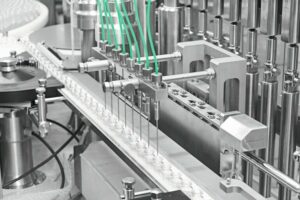According to Bernard Favre-Bulle, automating complex systems comes down to influencing changes in the conditions of the processes operating therein in a specific manner so as to achieve a system performance in accordance with the requirements profile. The purpose of the following essay on a system designed and installed by Frewitt is to show what a process automation system for processing bulk goods with very different product properties might look like.
The author: Luc Vuichard Project Manager Automation Frewitt
Metformin hydrochloride, magnesium and calcium salts, corn starch and lactose are the raw materials to be processed. They are put into 25 kg polyethylene bags (primary packaging) inside cardboard boxes (secondary packaging) for temporary storage. The product is man-ually emptied from the polyethylene bags into an infeed hopper, then crushed, de-agglomerated, ground to a freely flowing powder and gravimetrically fed into a container on a floor scale. After dust-free filling with the precisely metered batch of all active ingredients and additives, the container then moves on to the next phase: the mixing process.
At this point it should be mentioned that a uniform grain size distribution with a low percentage of fines is sought in order to prevent the product from settling out. Preliminary product tests had to be performed before it could be determined which system was suited for the aforementioned processes. In consultation with the client, the German Aenova group, it was decided to conduct tests with the products at the Frewitt Tech Center and then evaluate the results in the laboratory.
First results
After the initial tests and given the diverse characteristics of the products, it soon became evident that only a multi-purpose system would be able to fulfil the requirements. Corn starch has a density of 0.65 g/cm³, whereas that of magnesium salt is 3.58 g/cm³. With metformin hydrochloride, not only the density but also the minimum ignition energy (MIE > 1000 mJ) and the ignition temperature of 390 °C must be taken into account. The moisture content of the products can vary from 0.1 to 15 %, with a not inconsiderable influence on the flow properties.
Along with the results of the tests that were performed, use was made of general know-ledge from actual practice, namely the fact that owing to their hygroscopic properties, solid materials lose their loose consistency and flow capacity either partially or entirely. This circumstance can lead to agglomeration, lump formation and the complete solidification of the powder in the delivered transport containers.
A certain tendency to agglomerate and cake over time due to storage was noted for all of the products. Lump and chunk formation was even observed in one of the products. On the basis of the product tests on the facility, the grain size analysis evaluated in the laboratory and the practical experiences acquired by Aenova it was decided to use the Delumpwitt system, consisting of a lump crusher and a milling unit.
From the product to the facility
Once the product properties were known and the overall design of the facility had been determined, it was necessary to specify the individual components on the basis of the Dragenopharm specifications. In a room with 5000 mm of available height, a facility had to be installed with a platform for the operator from which the latter could empty the product from the polyethylene bags into an infeed hopper. The product then had to be gravimetrically conveyed from the hopper to a module for de-agglomeration and milling. A cut-off valve had to be installed at the discharge from the milling system in order to prevent spills. A special docking device would then ensure that the precise weight of the product would flow from this site into the container in a dust-free manner.
Next, the relevant system components for achieving these requirements had to be clarified: specific material properties or high demands on the client’s part imposed strict constraints on the use of standard lump crushers, especially since the latter soon reach their limits in terms of process performance and GMP compliance. Another disadvantage of standard systems lies in having to use two separate machines (a lump crusher and a milling unit). This two-step method generates higher purchase costs, slows down the process and also requires more space.
The inner infeed cone with static mandrels installed downstream of the infeed hopper helps break up block materials that have become compacted and caked over time. These materials are comminuted in the primary crusher and then ground to the final grain size in the milling system. This sums up the core of the system, namely the Delumpwitt, in which a lump crusher in the standard sense is dispensed with. At the inlet to the Delumpwitt there is an attachment for suctioning off the dust-laden air and an ejector chute for disposing of the empty polyethylene bags. CIP nozzles are installed in the top and bottom sections. The facility is designed for cleaning with isopropanol, AP and other approved solvents.
The interchangeable sieve inserts, configured with round or square holes or as rasps, and the continuously variable rotor speed control are key elements for achieving a uniform grain size distribution with a low percentage of fines. Since dry products were to be milled on this facility, rotor arms with square profiles were installed. Safety was taken into account in the design of each part of the system: a magnetic limit switch mounted on the infeed ensures that the facility will only start if the hopper is correctly mounted. The temperature is regulated by means of a gas-flushed drive bearing with flow measurement and a pressure-reducing valve, thus protecting both the bearing and the product from contamination in the milling chamber. A spill prevention device consisting of a pneumatic rotary drive was attached to the discharge of the Delumpwitt. This element prevents any further discharge of material from the milling chamber into the container once the preset batch weight has been reached.
Continuous tracking and tracing
The automation concept was planned down to the last detail and adds the final touch to the facility: interaction with the system and the processes on the strategic (process control functions), tactical (controls) and operative (sensors and actuators) levels. The facility of the aforementioned Frewitt client was installed on two decks: the OP 177 terminal with the operator interface is on the upper deck while the operator can read the weight from the floor scale at a second terminal on the lower deck. The electrical controls are compliant with GAMP 5 directives. Products, production batches, administrators, users and system access can be managed and documented, thus ensuring continuous tracking and tracing. The integrated Siemens Scada system additionally enables all process steps to be documented on an office PC. The Frewitt solutions keep pace with increasing client demands. Customers who chose Frewitt are not left to their own devices and can always count on reliable advice.
cpp-net.com/0213402
Share:






